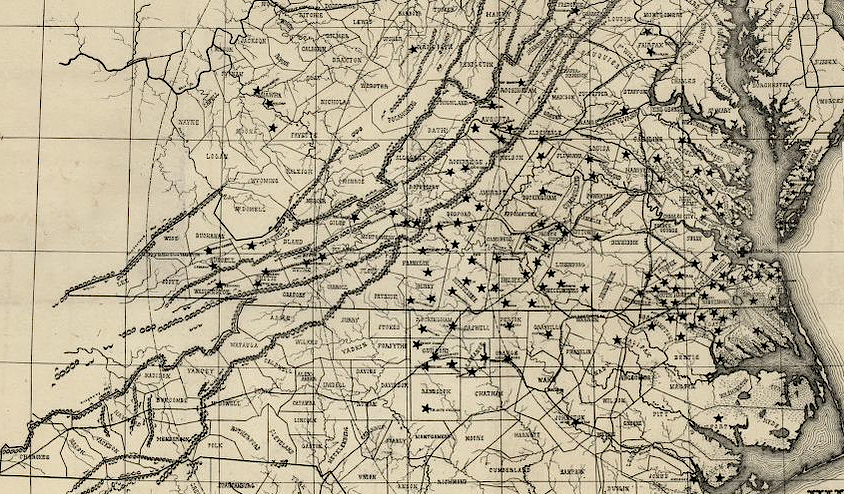
locations of schools taught by graduates of the Hampton Normal & Agricultural Institute from 1871 to 1876
Source: Library of Congress, Map of Virginia and West Va., North & part of South Carolina, Maryland & Delaware... (1876)

locations of schools taught by graduates of the Hampton Normal & Agricultural Institute from 1871 to 1876
Source: Library of Congress, Map of Virginia and West Va., North & part of South Carolina, Maryland & Delaware... (1876)
When enslaved people fled to Fort Monroe at the start of the Civil War, Union General Benjamin Butler declared them to be "contraband of war." He refused to force them to go back with Virginia slaveowners who demanded their return.
A free person of color, Mary Peake, taught the first formal class in the contraband camp on September 17, 1861. The oak tree on the grounds of Hampton University, where about 20 people gathered to be in the shade, is known today as the Emancipation Oak since the Emancipation Proclamation was read to an assembly there in 1863. General Butler formalized the training and initiated the Butler School, where the educational program for formerly enslaved people continued during the war.
In 1866, Samuel Chapman Armstrong was appointed Superintendent of the Freedmen's Bureau for the district in Virginia that included the Peninsula. In 1868 he opened the Hampton Normal and Agricultural Institute to "to train selected Negro youth who should go out and teach and lead their people." Funding was provided in part by the American Missionary Association. Students trained at the Hampton developed their skills by teaching at the Butler School, which continued in operation on an adjacent parcel of land.1
Virginia voters approved a new state constitution in order to re-enter the Union. When it went into effect in 1870, the new constitution ended the prohibition against teaching blacks and mulattoes how to read and write, a constraint imposed after Nat Turner's rebellion in 1831. The 1870 constitution included a requirement to create free public schools for all children irrespective of race:2
Booker T. Washington walked to Hampton and became a student there in 1872. Like the vast majority of graduates in the first 20 years of the school, he became a teacher. He joined the faculty at Hampton, then in 1881 helped start Tuskegee Institute in Alabama.
In addition to training black Virginians, Hampton Normal and Agricultural Institute also enrolled Native Americans. The first group had been seized during the Red River War in 1874, when Native Americans left their assigned reservations in Oklahoma. In 1878, 70 people from Southern Plains tribes were sent to Hampton to be educated. The training of Native Americans continued there until 1923.
The school was renamed Hampton Institute in 1930. It was always led by white men until Dr. Alonzo G. Moron became president in 1949.
Hampton students staged the first lunch counter sit-in in Virginia in 1960. In 1978, Dr. William R. Harvey became the 12th president; he served until 2021. In 1984, early in his extraordinarily long tenure, the school was renamed Hampton University.3